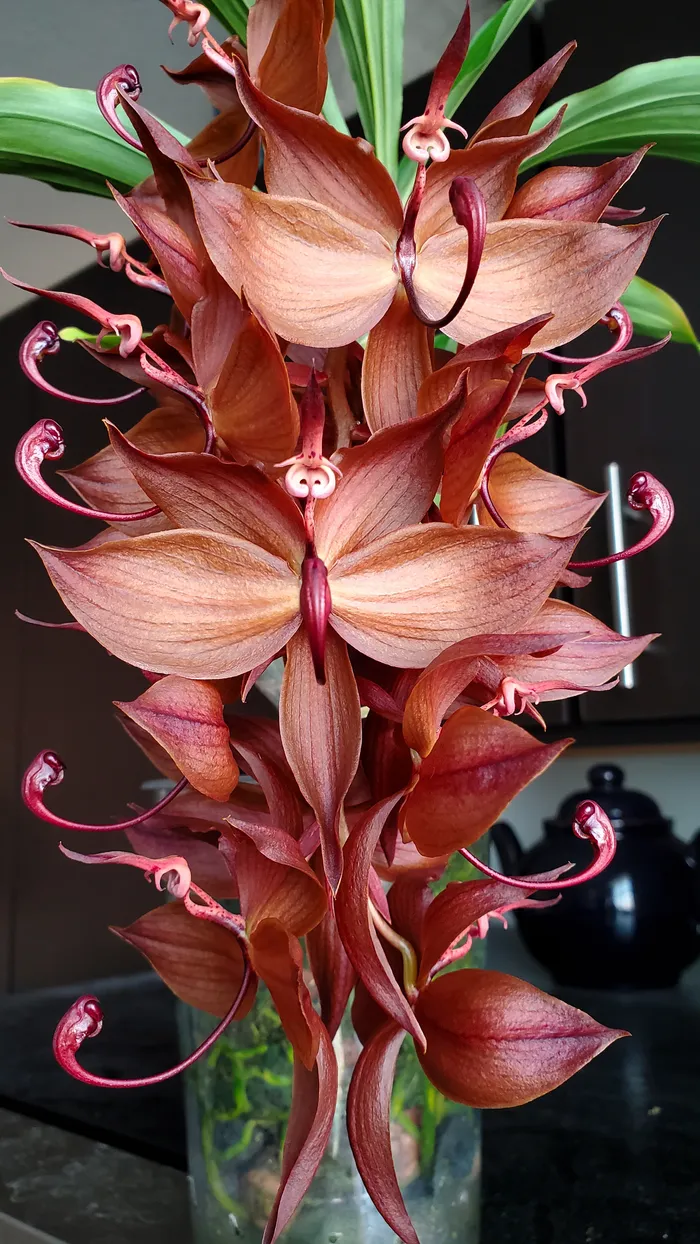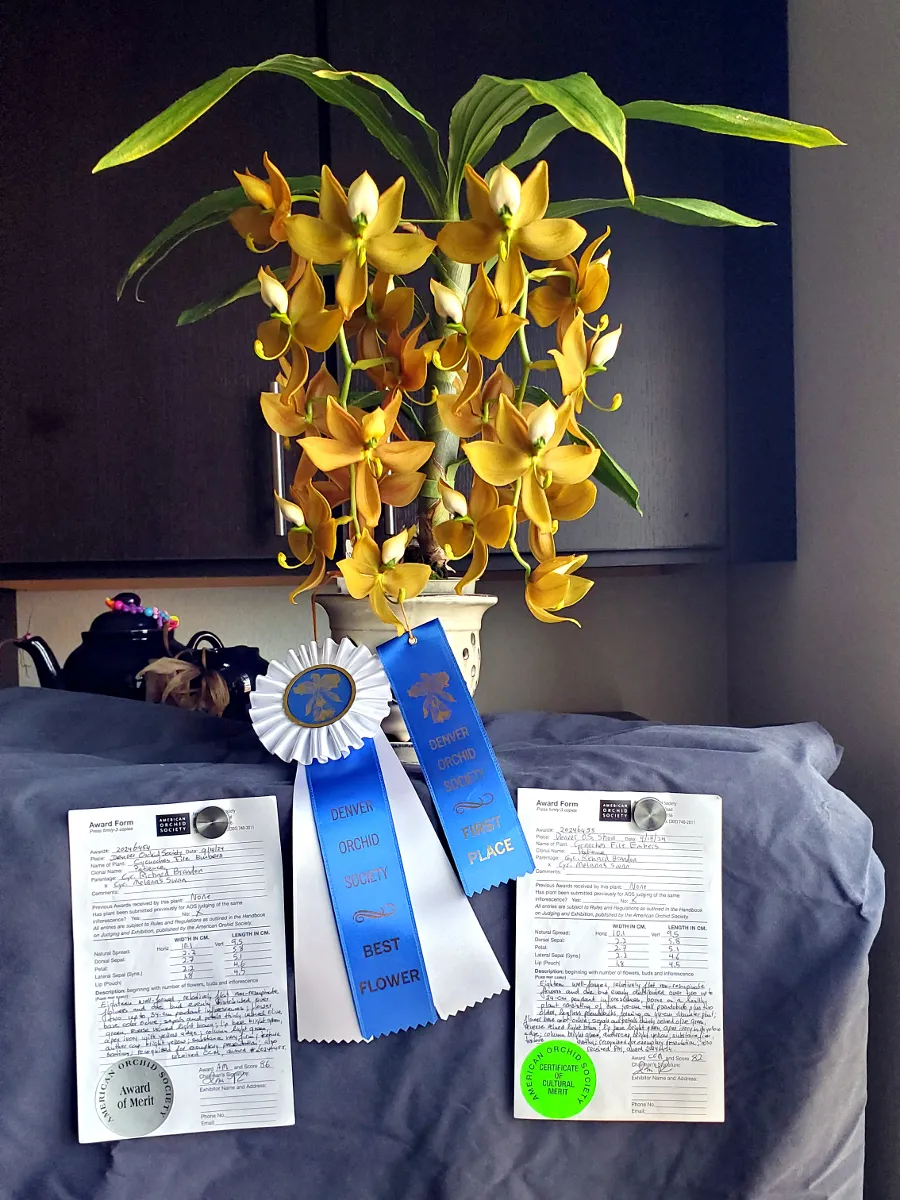Cycnoches
Published October 26, 2024
Last updated November 23, 2024

Photo: Cycnoches cooperi ‘Copper’
For me, there is no doubt that Cycnoches are the most elegant of the Catasetinae tribe. They have so many redeeming qualities: impressive displays of large, striking flowers; strong, sweet fragrance; vertical growth habit, and minimal care required during their few months of winter dormancy.
Potting: Mine are all in sphagnum, with some granite rocks at the bottom of the pot. I tried the PET potting method with a few different Cycnoches this growing season and it seemed to do very well. It’s amazing how much moisture these plants will absorb if you provide it.
PET is (I assume) named after the PET bottles which many growers use for this potting method. I use large cottage cheese and yogurt containers. You just poke a couple holes in the side of the pot about 2 cm from the bottom and it makes a handy reservoir of water and fertilizer for the plant. Then pot up as mentioned above.
Temperature and humidity: My grow tent generally reaches 29°C during the day and is air conditioned down to 18°C at night throughout the growing season. Temperatures are a few degrees cooler on both ends in the winter. Humidity averages 60%.
Light: The plants sit under two Spider Farmer SF1000 LED panels in the afternoon and receive sunshine from an east window in the mornings for a total of about 12 hours of daily direct light.
Water: As with other Catasetinae, I do not water the new growths until the roots can be seen reaching deep into the pot, even waiting until they are at the bottom. I usually spray the top of the medium until the moss has gone from crispy to soft and moist all the way through. From that point, I drench the plants regularly, doing my best to keep the moss moist throughout the rest of the growing season. I let the plants dry slightly between watering to allow air to reach the roots, but the moss stays moist and spongy, never crispy.
In late autumn, after blooms have faded and the bulbs have fattened up completely, I will start becoming more sporadic with my water. I use the first day of winter as the cutoff date for all watering to these plants. One thing that I have found with Cycnoches is that they need water while they are growing out their spikes. If you start cutting back on the irrigation before the plant has bloomed, it may drop its buds, or simply produce fewer of them.
Fertilizer: I have read countless times that Catasetinae can take fertilizer at ‘normal’ application rates, rather than the classic 1/4 tsp per gallon that seems to be the standard for orchids. I have been fairly cautious about this, but still have seen good results. This growing season I watered with my standard 0.2 g/L (1/6 tsp per gallon, 25 ppm N) 12-1-1 solution, but I also added 1 teaspoon of Osmocote 19-19-19 pellets to the Catasetinae. I got good results again, with one plant even earning an Award of Merit as well as a Certificate of Cultural Merit. Fred Clarke, in an interview with Stephen Van Kampen-Lewis, said that he pushes fertilizer levels to their highest, 200 ppm N with every watering, in July and August.

Photo: Cycnoches Fire Embers ‘Patience’ a day after receiving an AM/AOS and CCM/AOS
Mites: For the past few years, mites have been a late season problem on my Catasetinae in general, but this past year has been the worst. I treat with neem oil solution, insecticidal soap, predatory mites, and I’m very interested in experimenting with carbon dioxide. The idea is to reduce their numbers to negligible, with total eradication reserved as an unlikely byproduct of successful treatment.
Dormancy: Caring for the plants during this period is pretty straightforward. Basically, keep everything the same except the amount of water they receive. Warm days and cooler nights, humidity of around 60% or higher, bright light, and good air movement—this should be very similar to the growing season conditions. I just don’t water them. In my conditions, the day and night temperatures do decrease a few degrees in winter, to an average high of around 24°C and a low of 17°C, and it’s possible that this helps trigger dormancy. I don’t know for sure. What I do know is that my plants have never had any issues during this period. They drop their leaves, and I leave them alone until spring.
I have read that some growers continue to water their plants sparingly during dormancy. I have done this inconsistently myself, sometimes as an unavoidable consequence of leaving the plants in the hands of an automatic watering system while away for the holidays. In general, I don’t see significant bulb shrinkage during the dormant period, so I don’t water. Only in the final stage of dormancy, when the plant is actively growing its new leads, might I run a bit of water through the dry media to introduce a small amount of moisture.
 Home
Home